
|   |

|   |
Shraddhanjali to Kelubabu and Sanjukta Panigrahi -Tapati Chowdhurie e-mail: tapatichow@yahoo.co.in October 9, 2022 Shraddhanjali to Guru Kelucharan Mohapatra and his iconic disciple Sanjukta Panigrahi was a much looked forward to festival held by Odissi Forum. This year they celebrated a three-day festival at Gyan Manch, Kolkata. Odissi Forum's aim is to provide Odissi aspirants a platform to present their art. With the audience of today and their multiple voices highlighted in social media and private forums those who are given the platform have the tough task of proving themselves. Some pass the acid test, some don't. One of the major reasons why classical dance evenings have less audience, could be that the fare is either not rich enough to sustain audience attention or it has nothing new or creative or artistic to offer. This time it was difficult to see the gems hidden in the haystack. With their aim in view, Odissi Forum accommodated many dancers, who in fact should not have been there for the lack of quality. The evening of the first day started with promising Odissi aspirant Chandrima Ghosh - a student of Pompi Paul - who was awarded the Parampara award this year, with the presentation of 'Matangi,' one of the ten Mahavidyas. Saraswati, the Goddess of music and learning representing the 64 kalas, the Tantric form Matangi was performed with elan. Chandrima's bhangis were taught with care and most importantly she had the capacity to imbibe it. Poushali Mukherjee who is one of Guru Kelucharan Mohapatra's disciples has trained many good performers. Her well trained disciples presented Kelubabu's choreographic marvel in raag Bagesri. Very adeptly they performed Gatibed Pallavi in taal ektali which incorporates five jatis - tisra, chatusra, khanda, mishra and sankirna. Arabi Pallavi, another unique creation of Guru Kelucharan Mohapatra, was the offering of Pompi Paul and group to pay their tribute to the legends. Raag Arabi's melodious quality was blended seamlessly into a graceful rendition so much so that the guru's work was immortalized. Shib Narayan Banerjee has the potential to be a soloist and this proved with the presentation of Shantakaram, which is a Dhyana Mantra about Vishnu. The frieze poses were rendered to perfection. The second day of the Shraddhanjali festival was enriched with the performance of the second Parampara awardee of 2022, Deyashini Guha, a disciple of Arnab Bandyopadhyay. She performed to a composition from Jayadeva's Gita Govinda "Srita kamala kucha mandala", expressing Krishna resting blissfully on the lotus like breasts of Lakshmi. The lyric contributed to Deyashini's excellence and hold over the Odissi idiom. Each activity in Hari's life was highlighted gracefully displaying complete bhakti with her body language. 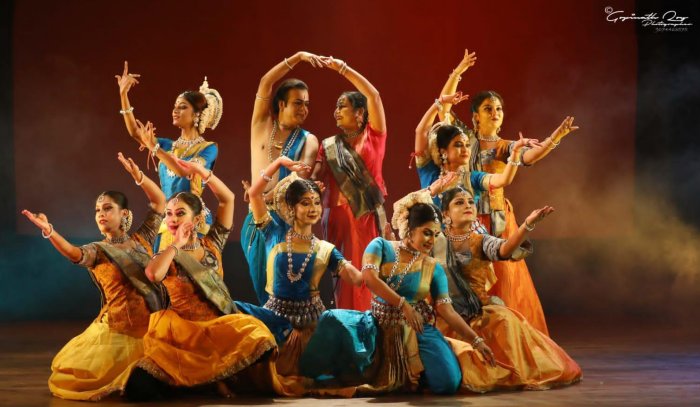 Rajib and Paromita's group Veteran dancer Monalisa Ghosh performed Mahisasura Mardini with her repertory members. Odissi dancer Rajib Bhattacharya, founder and artistic director of Srijan Chhanda, and his group joined Nrityangan Kathak Kendra's founder and artistic director Paromita Moitra's group to present an Odissi-Kathak yugalbandi. It was an out-of-the-box performance enjoyed by aficionados. Theirs was a tribute to both their gurus, Guru Kelucharan Mohapatra and Pandit Birju Maharaj. It was a creative fusion between Odissi and Kathak which began with a Guru Vandana sung by the maestro Birju Maharaj himself followed with Odissi Mangalacharan. The Odissi group and Kathak group participated in both enriching the piece manifold. Very significantly the piece ended with a sawal-jawab in the fashion of a Kathak repertoire which combined the two great classical dance forms of the land. Maya Bhattacharya and group performed Krishna Madhurya in praise of Krishna to a Hindi lyric in Odissi style. The song in the voice of Debasish Sarkar gave the piece its fillip. Radha and Krishna enjoy their blissful dance on the banks of Yamuna. Kathak bols were translated into the rhythm of Odissi. The group of four male dancers along with Maya herself ended the piece with the chant "Gobinda hare hare, Gopala hare hare" while they enacted the ten incarnations of Vishnu. Arnab Bandyopadhyay and his group's performance of Ananta was worth a watch. It dealt on the theme of cosmic creation and the five physical elements or Panchabhuta. An innovative production, a great deal of research and delving deep into the Vedas and Upanishads seems to have gone into it. The dancers were in top form with Arnab Bandyopadhyay at the lead. Artistic director of Nrityayan, Subikash Mukherjee and group of four girls played with rhythm in Lahari after paying their obeisance to their guru. More perfection and polish would have raised the standard of the piece. Odissi performer Shayomita Dasgupta joined with Bharatanatyam performer Samrat Dutta to present Moola Durga, which according to the Southern school of tantra is Shree Kula while it is Kali Kula in Gaudiya Tantra. The four handed Devi Simhavahini resplendent with the moon on her forehead and her other accessories as mentioned in the Dhyana Mantra was described in great detail. This was performed to a composition of Bani Kumar in raag Bhairavi. The tune of the song reminded me of Mahisasuramardini and chandipath, which is aired in the early hours of Mahalaya, which marks Devipaksha. The duet dance allowed us a glimpse into the two different styles of indigenous classical dance forms. Lately there has been a change in presenting the Bharatanatyam form by modern day practitioners. On many occasions the basic structure of the traditional aesthetics of ardhamandali essential to the form is replaced with a half sitting posture with both feet wide apart. Samrat has the poise of a Bharatanatyam dancer. 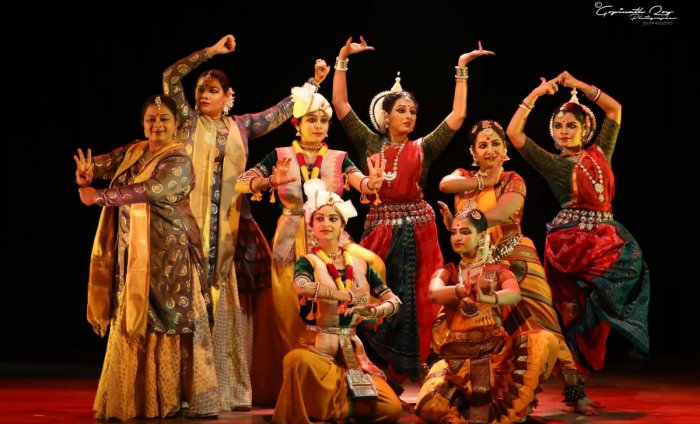 Arpita Venkatesh's group Arpita Venkatesh and group presented Chatuprana - a collage of four Indian dance forms - Odissi, Kathak, Manipuri and Bharatanatyam, exploring both tandava and lasya. It commenced with Shiva Vandana. Panchakshara stotram was at first performed by each of the forms gradually merging into a single pattern much like the different rivers merge and flow into the sea. The theme of the dance was conceptualized with the joint effort of Odissi dancer Arpita Venkatesh, Kathak dancer Sampita Chatterjee, Manipuri dancer Sruti Bandopadhay and Bharatanatyam dancer Sanchita Munshi. The group was very original which was appreciated by all. Ananda Bhairavi by Nilanjana Mukherjee of Shinjini Nrityalaya was group choreographic work with nothing new to offer. 'Radhika's Manbhanjan' by Manipuri dancer Sudip Kumar Ghosh and Odissi dancer Sushmita Bhattacharya held promise, however Krishna's remorse and Radhika's hurt was not explicitly visible in their body language. On the final day of the festival, Odissi dancer Sujata Mohapatra was a connoisseur's delight. The organizers however marred the veteran's performance by their lapses in lighting. Sujata who is always greeted with encore from the audience, managed her performance of Mangalacharan and Ardhanarishwar by her sheer grit. At once she was the devotee genuflecting to Lord Jagannath, soon changing into Shiva and Parvathi with tandava and lasya bhangi coexisting in one body as Ardhanarishwar. Her transformation was truly amazing. 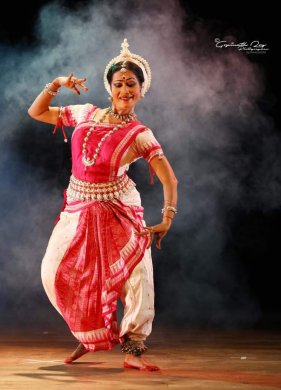 Sujata Mohapatra 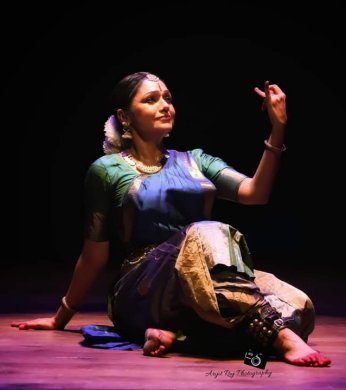 Rama Vaidyanathan Impeccably trained in Bharatanatyam, Rama Vaidyanathan is well equipped to create her own vocabulary, and has found her place in the hearts of her rasikas. In this forum, where she performed in a jam-packed hall, she chose verses from bhakta Meera Bai's Padavali and adeptly formatted them into a varnam. The metaphor of monsoon described her journey of love. To describe happy tidings and love feelings, when rain soaked, her expressions were lokadharmi, while in the nritta element which followed soon after, it was Bharatanatyam in its pristine form, earning her audience appreciation. Jatayu Moksha or the salvation of Jatayu - the legendary old eagle of the Ramayana - by Sri Rama presented by Guru Ratikant Mohapatra, left a mark in this festival. Jatayu's valiant fight against Ravana to prevent him from making an escapade with Sita and staying alive to give the lead to Rama when they were looking for her, dying subsequently to redeem his soul was presented tellingly. A difficult theme for a dance was made vibrant and alive by the choreographer cum performer that made everyone hold their breath right till the bird breathed his last. Ratikant Mohapatra has enriched the vocabulary of Odissi by incorporating new steps in his production. 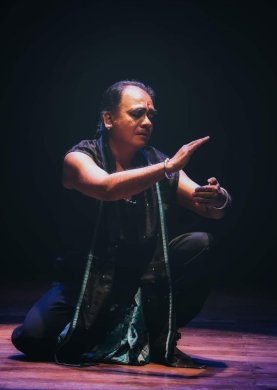 Ratikant Mohapatra 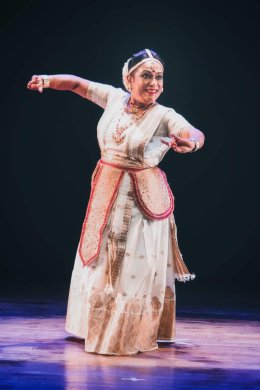 Anita Sharma Sattriya dancer Anita Sharma performed Krishna Vandana followed by the very graceful lasya dance to a borgeet composition of Madhavadeva, a bhakti saint of 16th century. The bhakti element was very pronounced in this piece. The theme centred around the activities of Krishna. Prerna Centre of Performing Arts under Kathak dancer Luna Poddar's Quest was the grand finale of the festival. It was performed to nine and a half beat taal, displaying all the intricacies of Kathak. Light design by Dinesh Poddar gave a proper dimension.  Tapati Chowdhurie trained under Guru Gopinath in Madras and was briefly with International Centre for Kathakali in New Delhi. Presently, she is a freelance writer on the performing arts. |